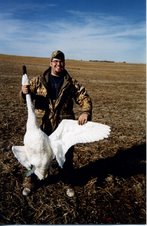
I started blowing a short-reed goose call about six years ago. At that time I was just one a few goose hunters I knew that actually blew one. It took me almost a full year until I felt really comfortable on a short-reed. At the time I felt like mastering my Big Guys Best “Fat Boy” was the biggest accomplishment of my short life. For years I had been hunting geese using a flute call. Recently my world has been crashing down around me as I have realized everyone and their grandmother can now blow a short-reed goose call.
I am always in the market for a new goose call. Either it is my human urge to never be satisfied, or a simple weakness that has gripped me along with a passion for goose hunting. Whenever I am at a sporting goods store I have to sample the goose calls. I am always looking for a deal and have found some good ones through friends, several retail stores and websites.
One of my college roommates used to buy and sell goose calls on E-bay like a day-trader on Wall Street. He had several lanyards full of calls before he realized that goose calls were not the most liquid and profitable investment. Still he managed to buy low and sell high, and to this day owns more calls then anybody else I hunt with.
One question that often comes up in the world of short reed goose calling is acrylic vs. wood. Personally I try to have an acrylic and a wood call on my lanyard when I take to the field. Typically, I use the acrylic to get the attention of the geese at vast distances, and then use the wood call for softer clucks and moans when the geese are close. There are many different types of wood short-reed goose calls and many of them are almost as loud as acrylic.
Some waterfowl calls have a wooden barrel and acrylic inserts. Like the Foiles Straight Meat “Spec” Call and the Big Guys Best “Death Whistle” duck call. These calls combine the soft tones of the wood with the volume of the acrylic. Short-reed goose calls are versatile by nature, allowing hunters to mimic the many different sounds of the Canada goose.
I have been encouraging my dad to switch from the long-goose caller or flute to the short-reed, but he does not have the time to change. Many older hunters are stuck in their ways or do not have efficient time to learn how to call geese on a short-reed. Although it is not the rule, goose hunting seems to be a passion of the younger generations. I believe this correlation comes from goose populations exploding within the last two decades.
Goose flutes will continue to have their place in goose hunting even though most of the younger waterfowl hunters begin their goose calling on short-reeds. For example, I have found that when hunting geese over water the mellow tones of a flute can be highly effective. Flutes can also serve a niche when hunting geese that are highly pressured by hunters, almost all of which call at them with short-reeds. For hunters who may have begun their goose hunting on short-reeds, an easy transition flute to try is the Foiles Meatcutter Flute.
The last couple years Minnesota has been establishing a Michael Jordan and the Chicago Bulls type dynasty in the world of goose hunting; leading the nation in goose harvest for the last decade. In 2004 and 2005 Minnesota hunters harvested more Canada geese than mallards, shooting roughly 234,000 Canada geese in 2004.
Today there are many talented goose callers across the nation. Some compete in contests, building their trophy and plaque collections. Others only call geese in the field, collecting memories and leg bands. These goose hunters all have the same common goal; mastering the clucks, moans and honks of the wild goose, to fool geese.

No comments:
Post a Comment